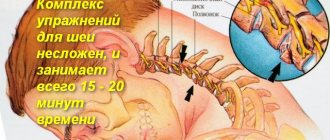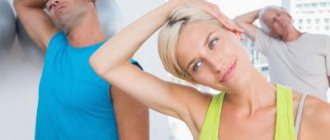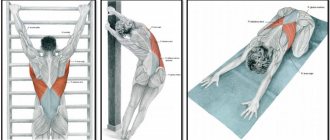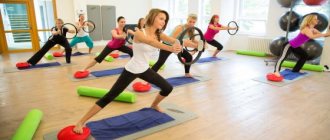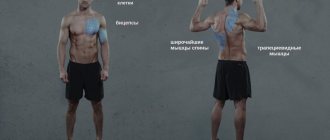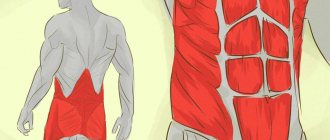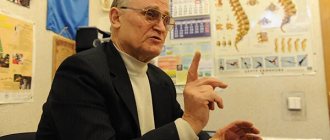Mirzakarim Sanakulovich Norbekov is the author of books on health-improving methods of treating the spine and the body as a whole, a follower of alternative medicine.
According to him, the basis for the treatment of many diseases is 99% in the normalization of a person’s psycho-emotional state and only 1% in the system of physical exercises he developed. Norbekov’s exercise, according to the author, helps in the treatment of joint pain, relieves hypertension and chronic fatigue syndrome, and puts you in an optimistic mood.
Description
M. S. Norbekov calls the main goal of classes according to his methodology the revelation of individuality in the fight against personal shortcomings and self-improvement of body and mind. The center he organized has developed methods that take into account age and gender. According to the author, this division is due to physiological and anatomical differences between men and women. Accordingly, exercises according to Norbekov are selected for cervical osteochondrosis and other pathologies, taking into account the physiological characteristics of a person.
Gymnastics objectives
In his books, Norbekov repeatedly says that it is impossible to achieve ideal physical shape and improve your health if you do not clear your mind. Regular training using this method helps only people with pure thoughts to heal their body and organism.
The main tasks of Norbekov’s exercises for joints and spine are:
- personal development and increased self-esteem;
- embodiment of creative possibilities;
- increasing both labor and social activity;
- formation of a positive attitude towards yourself, your body and faith in your own capabilities.
The essence of Dr. Norbekov’s technique
Norbekov’s gymnastics for the spine is a component of general joint gymnastics, including exercises for working out almost all joints of the body . The exercises are quite simple, and it is enough to do them a couple of times to remember them.
Exercises make it possible to combat spinal curvature, improve the condition of the intervertebral discs and the functioning of the spinal column as a whole. A healthy spine also has a positive effect on your overall health.
The main objectives of this technique are as follows::
- Achieve control over your body, restoring mobility and a normal rhythm of life.
- Feel the joy of movement and feel healthy and youthful. Loads help you feel a surge of vigor, improve flexibility and plasticity.
- Improve your overall health of the body. The author of the method is confident that the spine is the entrance to the internal system of the human body, through which we can set all the “settings” for health.
Gymnastics consists of two parts:
- the exercises themselves for the joints;
- training of the circulatory and nervous system;
- improving your inner world and increasing self-confidence.
The right attitude is very important. You must believe in your healing. According to the author, this is the main key to success. You must send a signal to your body that exercise will lead to success. This is not easy to achieve, but it is important.
Before you begin the exercises directly, you will need to tune in to them psychologically. The author insists on the importance of conscious execution . At the same time, you need to understand the structure of the spine. When working on a specific area, you should concentrate on it as much as possible and not use the rest. Then another department is worked out, and thus all the gymnastics are performed sequentially.
Among the advantages of such a system, it is worth highlighting its accessibility - it does not require any material investments, and you can perform the exercises at home. Plus, it's really effective if you do it right.
The disadvantages include the presence of contraindications. In addition, keep in mind that due to the importance of the psychological factor, a stable nervous system will be required.
Indications and contraindications
Therapeutic exercises are recommended for people suffering from:
- osteochondrosis;
- intervertebral hernia,
- vision problems;
- depression;
Before starting gymnastics, you should definitely consult a doctor; if pain occurs or your condition worsens, you should stop exercising.
Exercises according to Norbekov for the spine are contraindicated for people suffering from the following diseases:
- pain in the spine;
- during the period of bearing a child;
- joint pain;
- various pathologies of the spine;
- inflammatory processes;
- during periods of exacerbation of diseases;
- recent surgery;
- stroke or heart attack;
- childhood;
- nervous system problems;
- painful sensations during exercise.
Who is contraindicated for charging according to Norbekov?
Despite the fact that the author himself assures that his gymnastics and health program has no contraindications, representatives of traditional medicine warn that for some diseases such exercises can harm health. Experts call the following pathologies contraindications for exercise:
- infectious, inflammatory and dystrophic diseases in the acute stage;
- acute pain syndrome in the back;
- severe heart disease (previous heart attack, coronary artery disease, tachycardia, bradycardia, etc.);
Cardiac ischemia - history of surgical treatment (if six months have not passed since the operation);
- spinal injuries;
- intellectual impairment (deviations in mental development).
It is better for persons with chronic diseases of the heart, spine or other recurrent pathologies to exercise under the supervision of medical workers in specially equipped physical therapy rooms.
Important! If during exercise a burning, dull or sharp pain appears in the back or other parts of the body, the exercises should be stopped. You should also refuse to continue exercising if symptoms appear that may indicate a disturbance in the functioning of the heart (dizziness, darkening of the eyes, ringing in the ears, shortness of breath, increased heart rate).
If severe pain occurs, the exercise should be stopped.
How to tune in?
The main condition before starting joint gymnastics is to create a positive attitude. Repeating certain exercises brought to the point of automaticity does not bring any benefit to the body.
Therefore, before doing Norbekov’s therapeutic exercises, you must:
- relax the body as much as possible, right down to the facial muscles;
- relieve tension in the internal organs to a slight feeling of languor;
- create a positive, perhaps even cheerful, mood;
- activate the body by massaging the ears; they can be rubbed and pulled up and down.
Before charging
Warming up is an essential part of any workout; it helps warm up your muscles and significantly reduce the risk of injury.
Several warm-up exercises before charging Norbekov:
- They stretch their arms out in front of them, clench their fists tightly and unclench them sharply.
- Slightly bend your shoulders forward and lift them up, as if shrugging your shoulders, and return to the starting position.
- Rotate your shoulders forward 4 times, then back 4 times.
- The right hand is raised up and placed behind the back of the head, the left hand is placed behind the lower back, then the hands are changed.
- Hands are placed on the waist, feet shoulder-width apart, with smooth rotational movements of the pelvis, you need to draw the number eight.
It is not recommended to listen to music during classes; you need to focus as much as possible on your own feelings; if for some reason it is impossible to train in silence, it is better to listen to natural sounds: birdsong, the murmur of water, and the like.
Exercises to relieve neck pain
For this exercise you need to use a fitball and an expander.
The complex represents the following algorithm of actions:
- attach the expander from below to the fitball, lie with your back on the fitball, grab the expander and move your hands back and forth;
- in the same position, raise your arms up and lower them,
- repeat the previous movement, but bending your elbows.
During this complex, the neck muscles tense and relax. With this effect, the pain syndrome quickly passes.
Exercises for myopia, farsightedness, glaucoma
As with any method of alternative medicine, people are divided into two camps: those who are categorically against such unmodern methods of treatment, and those who have proven from personal experience that it helps. Likewise, among the numerous reviews of people who have tried eye exercises using the Norbekov system, there are many enthusiastic responses and accusations of the uselessness of the method.
The key points of charging according to Norbekov should be noted:
- during exercise you should keep your back straight; the author more than once notes the importance of the muscle corset and spine;
- be in the mood for a positive result, and what’s even better is to believe that the person is absolutely healthy.
A person suffering from myopia sees objects at a distance blurry and well up close, while a person who is farsighted sees objects clearly, on the contrary. The cause of the disease of both is poor focus. Eye gymnastics according to Norbekov trains weakened muscles of the eyeball and adjusts focus.
The term glaucoma refers to dozens of serious eye diseases, including:
- increased eye pressure;
- eye dysfunction;
- damage to the optic nerve and its possible atrophy.
In some cases, drug treatment is used, sometimes surgery is performed, and there are often cases when the disease is incurable. M. S. Norbekov claims that the gymnastics he developed helps cure eye diseases, and recommends performing exercises for preventive purposes.
During gymnastics, you must follow the principles:
- each finger touch on the eye is performed in a vertical position without rubbing;
- the amount of pressure required is somewhere between a light touch and a painful sensation;
- All movements are made with the pads of the fingers.
After completing the gymnastic complex, a small acupressure facial massage is recommended. Apply gentle pressure along the wings of the nose, along the edge of the hair, pressing on the hollow in the chin area, between the eyebrows and in the temporal part.
What is the Norbekov system
In 1997, the Institute of Human Self-Healing was created in Moscow. The founder is Dr. Mirzakarim Sanakulovich Norbekov. He was born in a mountain village near Samarkand, Uzbekistan. Norbekov developed his methodology on the basis of Eastern philosophy and gymnastics. Despite the fact that the method is unconventional, positive reviews from patients indicate that gymnastics works. The main principle is to perform all exercises with a smile on your face and a positive mood. Norbekov’s gymnastics is divided into 3 stages:
- elementary;
- preparatory;
- basic.
Doctor Norbekov is confident that a morally healthy person can independently improve his body. Basic principles:
- Charging according to Norbekov has a clear scheme: first, the muscles of the neck are developed, then the shoulders, arms, pelvis, and so on. First the upper body, then the lower.
- The doctor divides the gymnastics scheme depending on age and gender.
- Attention should be paid to the entire spine, and not just the area that hurts.
- The result will be noticeable only with regular training.
The patient also needs to focus on the goals of joint gymnastics according to Norbekov:
- comprehensive body health;
- body control;
- restoration of spine flexibility;
- improved mental health.
When performing exercises according to Norbekov, you should discard all unnecessary thoughts and focus on the place that works. As you inhale, the muscles tense, and as you exhale, they relax.
Eye exercises
Complex exercises (gymnastics) for the eyes with Mirzaakhmat Norbekov goes like this:
- Keep your head straight, without throwing it back. The eyes look up, mentally aiming higher and higher across the forehead.
- The head is held level, the eyes are lowered down, mentally continuing the movement through one’s own throat.
- Look away to the left, mentally continuing the movement through the left ear.
- Look away to the right, mentally continuing the movement through the right ear.
- The head is kept motionless, and with circular movements of the eyes they try to draw the largest possible picture. Start the exercise from the lower left corner moving to the upper right, then from the lower right to the upper left. Then we do the exercise in reverse order. After this you need to blink quickly.
- The head is motionless; an inverted number eight is drawn in front of the nose with circular movements of the eyes. Just like in the previous exercise, moving from one corner to another and vice versa. After that, blink quickly.
- Squint your eyes at the tip of your nose and place your finger on it, fix your gaze, relax and look in front of you, while noticing side objects, your eyes do not move.
Hand exercises
Charging according to Norbekov for the joints of the upper extremities includes exercises:
- Stretch your arms in front of you, clench and unclench your fingers, concentrating on the actions.
- Alternating hands, make sharp clicks with your fingers.
- Make fan-shaped movements with your fingers, starting with the little finger, then in the opposite direction, starting with the thumb.
- Shake your hands.
- Stretch your arms forward, hands down, then smoothly turn your hand up. Now the hands look up and smoothly pull them towards you.
- Extend your arms straight, palms down. Turn the brushes inward towards each other, then in different directions. Shake your hands.
- Make circular movements with your fists clockwise and counterclockwise.
- Spread your arms to the sides and bend them so that your fingers rest on your shoulders, make circular movements in one direction and the other. Shake your hands.
- Make a mill with one hand then with the other hand.
- Straighten your back, arms along your body. We move our shoulders forward, as if trying to close them, then back.
- Lower your shoulders down, then lift them up towards your ears.
- Concentrate on the shoulder joints and make circular movements with your shoulders forward, then back.
- The back is straight, the arms are lowered down along the body, the hands are turned inward towards you, then away from you. Shake your hands.
- Feet shoulder-width apart, take your left elbow with your right hand and pull it back at neck level. Do the same with the opposite hand.
Thanks to gymnastics, joints are warmed up and blood circulation improves.
Norbekov’s gymnastics for the spine: a set of exercises
The author of the method himself, while describing his own system, claims that only 1% of success is exercise, and the remaining 99% is a positive attitude and the psychology of suggestion. The latter will help create the right mood. In your thoughts you need to imagine the feeling of pleasant languor, which is a consequence of gymnastics (any exercises for Norbekov’s spine are done directly in this state). While performing movements, you should develop positive character traits within yourself in your thoughts, which include:
- the ability to fully exercise control over one’s own body and mood;
- calm and determination;
- self-confidence and other traits that a person believes he lacks.
It is prohibited to perform gymnastic exercises on the machine. You need to feel all the movements and enjoy them. Gymnastics for the spine according to Norbekov provides maximum focus directly on the joints, other movements are considered as auxiliary. Mostly the training is a consistent stretching movement.
Exercises for the cervical spine
The most common trainings for the cervical spine include:
- Tilt your chin to your chest. At the initial stage, you should relax and go down smoothly. Tension increases little by little and must be alternated with relaxation. Only in such a situation is the greatest effect achieved.
- This training will be the opposite of the previous one. In such a situation, you need to tilt your head back so that your chin points upward. Relaxation and tension must be alternated.
- The shoulders are fixed, then you need to alternately tilt your head to the sides. At the end point, the ear touches the shoulders.
- With your chin pointing upward, you need to turn your head to the sides. During the training period, the neck muscles should not be overstrained. Minimal effort is put into every movement.
- A similar movement, only with the difference that the chin is directed towards the surface of the floor.
- Twisting for the cervical spine is not as simple as it seems at first. The gaze is directed to the right side, and the head gradually turns.
- A similar movement is made to the left. Any gymnastic exercise must be properly completed. For these purposes, you need to make movements in a circle with your head. Everything happens slowly and under control. In this way, it will be possible to eliminate muscle tension and consolidate the results of the training.
Each exercise for the cervical spine should be performed slowly, at a measured pace. Sudden movements and jerks can provoke dislocations and injuries to the ligaments, in particular when a person leads a passive lifestyle or works in an office (in this category of people the muscles are often in spasms).
When everything is done properly, it is possible to quickly see the results of the work. Before starting such exercises, you should consult your doctor regarding possible restrictions. Self-treatment can worsen the general condition.
Exercises for the thoracic spine
The most common trainings for the thoracic region include:
- Hands clasp together in front of you. The chin is pressed to the chest, directed towards the shoulder joints. The back is kept straight, the lumbar region is fixed. You should not hold your breath.
- A similar training, but the hands are “locked” behind. The joints of the shoulders are pulled back, the shoulder blades do not move together. In this position, the sternum tends upward.
- One shoulder rises up, the other goes down. It is required to alternate tension and relaxation.
- Hands lower, reach them towards the surface of the floor, shoulders drop. The pelvis is pulled in front of you, the spinal column is kept straight, you need to fixate in a similar position. The shoulders rise as high as possible, reaching the top of the head towards the ceiling.
- The shoulder joints rotate forward, then in the opposite direction.
- The lower limbs are spread out, the feet seem to be glued to the surface. The elbows are spread to the sides, the hands are placed on the shoulders, the gaze is directed forward. Initially, the eyes turn, then the head, then the shoulders and chest. The hips and stomach do not move. The turn is performed to the maximum point and a little further. Similar training is carried out in the other direction.
- The training helps to work out the spinal column from the cervical to the lumbar region. The position is taken as if you are grasping something large with your hands. The head tilts down and tenses. Next, the arms are pulled back, the top of the head is pulled up and slightly back, the sternum is pulled up.
- You need to level up, the arm bends behind the head, at this time the elbow is directed towards the ceiling, the gaze is directed behind the elbow.
- A stretch is performed and the hand is changed. Slow movements are performed in a circle with the shoulders, trying to ensure that the amplitudes are maximum. A similar thing is done on the other side. During the training, you need to feel the wave inside the entire spinal column.
- Fists are placed in the kidney area. The elbows are brought as close as possible with springy movements, the spinal column is arched in front of you.
- The tailbone moves forward. The position in the lumbar region is fixed and the spine bends in the opposite direction.
- The hands are placed on the shoulders, the lower limbs are spread apart, the feet remain motionless. The gaze is turned to the side, then the head and shoulder girdle, chest, and abdomen are turned. Repeat in the opposite direction. At the same time, the pelvis does not move.
Such gymnastic exercises are especially useful for children and adolescents, as they make it possible to correct the initial stage of scoliosis and prevent curvature of the spinal column and stooping.
Exercises for the lumbar spine
Norbekov’s gymnastics for the lower back of the spinal column:
- The lower limbs are slightly spread and half bent. The pelvis is directed in front of you, the body is fixed. The tailbone stretches downwards with springy movements.
- The lower back bends. The back is kept straight. The tailbone reaches towards the back of the head.
- The spinal column is bent in an arch. The load is distributed evenly.
- The body bends in front of itself, the knees bend slightly. The tailbone is pulled towards the back of the head with springy movements, and a deflection is made in the lumbar region.
- The lower back bends, bending backwards. The tailbone reaches towards the back of the head.
- Make rotational movements in each direction. It is necessary to remember positive emotions.
- The hip moves to the right side and back. Perform springy movements with the thigh to the side. Next, a tilt is made to the abducted hip. The other thigh is abducted and the exercise is repeated.
- Feet are placed together. One hand rises vertically and strives upward, as if trying to touch the ceiling. The limb is replaced.
In addition, Norbekov’s gymnastic exercises involve twisting for the spinal column:
- The lower limbs are spread out, the feet are fixed. You need to try to distribute the load evenly. Movements are smooth and painless. Hands are placed on the shoulder girdles. You should slowly turn in the following sequence: initially your gaze, then your head, shoulder girdle, sternum, stomach, hips, lower limbs.
- A turn is made to the maximum point. You should tense up, then relax. The exercise is repeated for the other side.
- Hands are placed on the shoulder girdles. The body bends and turns, directing the gaze upward behind the elbow. Force is added and a turn is made to the maximum point. Next, do twists around the axis of the spinal column in the opposite direction.
- The straightened back leans back, hands are placed on the shoulders. You need to turn in this way: first the gaze, then the head, shoulder girdle, sternum, stomach and hips. They are collapsed to the maximum point and tension is added. The same is done for the other side. Finally, you need to take deep breaths to calm down.
Systematic implementation of such training will make it possible to increase the flexibility of the spinal column, muscle elasticity, improve mood and normalize the functioning of organs. Chronic pain in the back, according to the author, will completely disappear after a month of such exercises.
Leg exercises
Norbekov’s joint exercises for the lower extremities are aimed at improving mobility and include the following exercises:
- With a slight spring, pull the toe down, then, with your straight leg, pull the toe towards you.
- Stand straight, raise one leg, bending the knee, turn your foot inward and then outward. Alternately tense and relax your leg.
- Feet shoulder-width apart, lean forward and place your hands on your knees. Make circular movements with your knees inward and then outward.
- Close your legs, hands on your knees, lean forward and straighten up. Rotate your knees first to the right, then to the left.
- Feet shoulder-width apart, raise your leg, bending at the knee, and move it to the side with light springy movements, repeat the same with the other leg.
- Feet shoulder-width apart, lift the leg bent at the knee and move it to the side, then lower it, pointing the knee forward, repeat the same with the other leg.
- With the leg bent at the knee pointing to the side, make several circular movements and repeat with the other leg.
Stretch your neck
Exercises according to Norbekov for cervical osteochondrosis quickly relieves spasms in the neck. It is recommended for many spinal pathologies. Gymnastics can be done during morning exercise or right at the workplace.
The set of exercises includes:
- The head is tilted to the side, touching the right ear to the shoulder, then the left.
- Repeat the first exercise, but now press your head with your hand on top.
- Tilt your head forward until your chin touches your sternum.
- Tilt your head back, trying to keep your chin looking up.
- Make circular movements with your neck, describing a circle or semicircle with your head.
- Place your chin on your sternum and slowly turn your head to one side, then to the other.
- Throw your head back and gradually pull up, alternately relaxing and tensing your muscles.
Gymnastics must be performed based on your own sensations. If you have neck pain, exercises should be postponed until you consult a specialist.
Consolidating self-massage after gymnastics
After performing any neck exercises, you should resort to a massage, which you can do yourself.
It is an algorithm:
- place your palms on your neck and, pressing lightly, move them from top to bottom;
- massage the neck with your fingers using rotational movements, which should gradually reach the shoulders;
- work with your hands where the shoulders meet the neck.
All movements should be soft and slow.
Exercises for the thoracic region
Exercises according to Norbekov for the back and chest are aimed at relaxing the muscles and stretching the spine. When performed correctly, after the exercises a person feels ease of movement.
The complex includes exercises:
- Hands are extended in front of you, closed with a lock and squeezed.
- Hands are placed behind the back, connected, trying to bring the shoulder blades together as much as possible.
- Alternately raise one shoulder up as much as possible, and lower the other down.
- Keep your legs motionless, turn your body in one direction and the other.
- The body is tilted to the right, trying to touch the floor, while the left hand is placed behind the head. Repeat in the opposite direction.
Exercises using the Bubnovsky method
Dr. Bubnovsky’s gymnastics is based on kinesitherapy or movement therapy. If a person does not play sports, smooth muscles gradually atrophy, compressing blood vessels and nerve fibers. As a result, blood flow and nutrition of organs and joints deteriorate.
What does Bubnovsky's technique give?
Therapy of osteochondrosis according to Dr. Bubnovsky’s method is carried out using special simulators. Working with them, a person strengthens weakened muscles and relieves tension without axial load on the spinal column. A special breathing technique reduces chest pressure, improving blood flow.
What exercises can you do at home? It is better to start training with an individual instructor. If this is not possible, some exercises can be done at home using improvised means.
The simplest exercises
Several Bubnovsky exercises for the cervical spine:
- "push ups";
- "pull over";
- "butterfly";
- "pull-up";
- “Push-ups on parallel bars.”
Below are descriptions of all and photos of some of the exercises from the described gymnastics.
"Push ups"
Place 2 chairs near the bed, at arm's length. The gap between them should correspond to the width of the shoulders. Place your legs and pelvis on the bed, rest your hands on the seats of the chairs, bend your elbows. As you exhale, straighten your arms and round your back like a wheel. Take a breath. Lower your body between the chairs, bringing your shoulder blades together. Take the original position and do 5 repetitions. The exercise is gradually made more difficult by moving the chairs apart.
"Pull-over"
To perform this you will need small dumbbells. You can use any available weights. Lie down on the bed with your head on the edge. Raise your arms with dumbbells perpendicular to your body, lower them behind your head. As you exhale, raise your arms perpendicularly again. Do 10 reps.
"Butterfly"
Lie down on the edge of the bed, take a dumbbell in one hand and lift it up. The limb should be perpendicular to the body. As you exhale, move your arm to the side, below the level of the bed, and while inhaling, return it back. Turn over and repeat the movement with the other hand.
"Pull-up"
For this exercise, you need to purchase a special device - a horizontal bar, which is fixed in the doorway. Sit on the floor, grab the horizontal bar with your hands, and pull your upper body towards the bar. When the muscles become stronger, the device can be raised higher.
"Push-ups"
Sit between 2 chairs, rest your hands on the seats, elbows bent. As you exhale, straighten your limbs, doing a bench press. Get down to the floor. Perform 5-10 push-ups.
On a note. The number of movements must be gradually increased. Daily strength exercises help strengthen the muscles of the cervical and thoracic regions, improve blood circulation, and stretch ligaments.
Exercises for the lower back
Norbekov's exercises (joint exercises) for the lumbar spine are necessary for those who experience pain in this area, as well as for the prevention of radiculitis.
The following exercises are recommended:
- Make full body turns 180° in different directions.
- Lean forward and bend as much as possible, while keeping your body motionless.
- Lean forward, arching your back, relax and fix the position for a minute.
- Standing straight, make smooth wave-like movements, starting from the chin and ending with the knees.
- Taking the lotus position, make pendulum movements.
Time frame for achieving results
Relief of symptoms is noted after the first set of exercises. However, in order to achieve lasting results, you should perform gymnastics daily for at least one month.
If problems associated with the cervical spine manifest themselves as unpleasant symptoms, then it is not necessary to use drug treatments. You can use gymnastics that were developed by such famous doctors as Shishonin, Baranov, Dikul. To perform these exercises correctly, you should use videos and recommendations from the authors of the methods.
Article design: Vladimir the Great
Results and effectiveness of the technique
Most patients who performed the exercises noted positive dynamics after just a few sessions. According to them, constant training improves the functioning of the circulatory system, relieves stiffness and activates muscle function, and promotes rapid recovery from injuries.
To improve your well-being, it is enough to do joint exercises according to Norbekov for 30 minutes a day. Each exercise is performed slowly, smoothly, without sudden movements. The complex of classes includes activities aimed at improving vision, gait, memory and general well-being.
Source
How to make training effective: training rules
In order for exercises for the spine to be not only effective, but also safe, you must adhere to certain rules. Norbekov recommends doing exercises for the back and the whole body every day, devoting at least 20-30 minutes a day to training, but an important condition for the formation of positive dynamics is the absence of a stress factor during exercise and a good mood. You need to start training only in a good mood.
If you want to find out in more detail what exercises cannot be done with scoliosis, and also consider prohibited loads, you can read an article about this on our portal.
Famous gymnastics for the spine from Mirzakarim Norbekov
In case of emotional stress or severe fatigue, you need to tune in to exercise using relaxing techniques: aromatherapy, audiotherapy, salt bath. You can simply rest a little in a lying position, but you should not do this for longer than 10-15 minutes, since a strong blood flow to the muscles can lead to excessive synthesis of lactic acid, which can be clinically manifested by increased pain in the back, a painful burning sensation (feeling that the spine is “on fire”), muscle weakness.
Audiotherapy will help you tune in to your classes
Other tips that will help improve the functional state of the spine and restore normal mobility of the vertebrae, as well as stop dystrophic and degenerative changes in the intervertebral discs, are listed below.
- Before class, the doctor recommends watching a funny movie or TV show. This will help you take your mind off everyday and professional problems and create the right mood.
- If you don’t have time to watch TV, you can make faces and fool around in front of the mirror. At the same time, it is recommended to carry out a passive massage of the earlobes: you can pull them, pull them, twist them and do any actions that can cause a smile.
- You should always start your workout with a short warm-up - this will help avoid excess lactic acid entering the muscle tissue.
You can make faces in front of the mirror
Important! Despite the fact that Norbekov himself claims that his gymnastics is suitable for any person and has no contraindications, it is recommended to consult a specialist before starting classes.
Consult your doctor first
